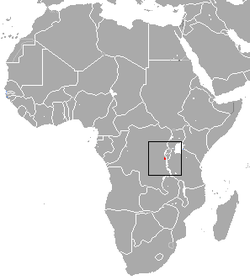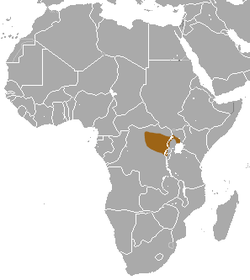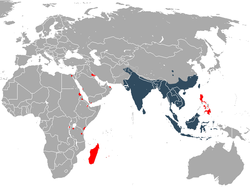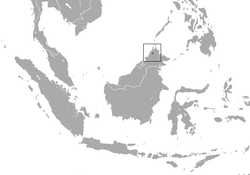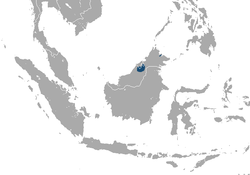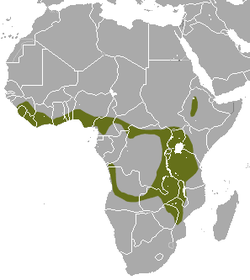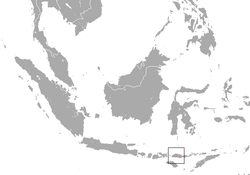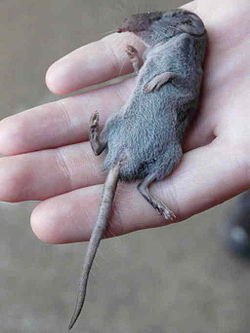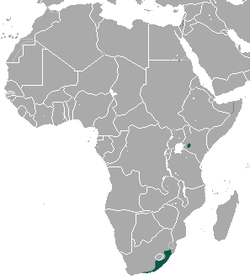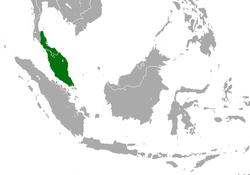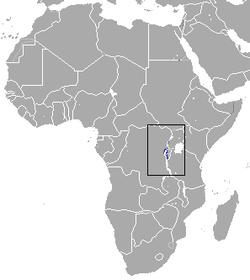| Common name | Scientific name and subspecies | Range | Size and ecology | IUCN status and estimated population |
|---|
| African black shrew
| C. nigrofusca
Matschie, 1895 | Central and eastern Africa
 | Size: 4–18 cm (2–7 in) long, plus 4–11 cm (2–4 in) tail [6]
Habitat: Forest [7]
Diet: Invertebrates, small mammals, frogs, toads, and lizards [6] | LC
Unknown  [7] [7]
|
|---|
| African dusky shrew
| C. caliginea
Hollister, 1916 | Central Africa
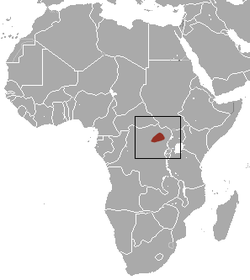 | Size: 6–8 cm (2–3 in) long, plus 4–6 cm (2 in) tail [8]
Habitat: Forest [9]
Diet: Invertebrates, small mammals, frogs, toads, and lizards [6] | LC
Unknown  [9] [9]
|
|---|
| African giant shrew 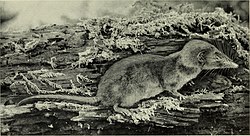 | C. olivieri
(Lesson, 1827)
- C. o. anchietae
- C. o. bueae
- C. o. cara
- C. o. cinereoaenea
- C. o. darfurea
- C. o. giffardi
- C. o. guineensis
- C. o. hansruppi
- C. o. hedenborgiana
- C. o. kivu
- C. o. manni
- C. o. martiensseni
- C. o. nyansae
- C. o. occidentalis
- C. o. odorata
- C. o. olivieri
- C. o. spurelli
- C. o. sururae
- C. o. toritensis
- C. o. zuleika
| Sub-Saharan Africa
 | Size: 11–14 cm (4–6 in) long, plus 8–10 cm (3–4 in) tail [10]
Habitat: Forest, savanna, and shrubland [11]
Diet: Invertebrates [10] | LC
Unknown  [11] [11]
|
|---|
| Andaman shrew
| C. andamanensis
Miller, 1902 | South Andaman Island in India
 | Size: 4–18 cm (2–7 in) long, plus 4–11 cm (2–4 in) tail [6]
Habitat: Forest [12]
Diet: Invertebrates, small mammals, frogs, toads, and lizards [6] | CR
Unknown  [12] [12]
|
|---|
| Andaman spiny shrew
| C. hispida
Thomas, 1913 | South Andaman Island in India
 | Size: 4–18 cm (2–7 in) long, plus 4–11 cm (2–4 in) tail [6]
Habitat: Forest [13]
Diet: Invertebrates, small mammals, frogs, toads, and lizards [6] | VU
Unknown  [13] [13]
|
|---|
| Annamite shrew
| C. annamitensis
Jenkins, Lunde, & Moncrieff, 2009 | Vietnam | Size: 4–18 cm (2–7 in) long, plus 4–11 cm (2–4 in) tail [6]
Habitat: Forest [14]
Diet: Invertebrates, small mammals, frogs, toads, and lizards [6] | DD
Unknown  [14] [14]
|
|---|
| Ansell's shrew
| C. ansellorum
Hutterer & Dippenaar, 1987 | South-central Africa
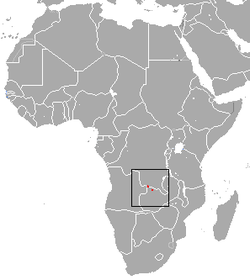 | Size: 5–6 cm (2–2 in) long, plus 4–6 cm (2 in) tail [15]
Habitat: Forest [16]
Diet: Invertebrates, small mammals, frogs, toads, and lizards [6] | EN
Unknown  [16] [16]
|
|---|
| Arabian shrew
| C. arabica
Hutterer, 1988 | Oman and Yemen
 | Size: 4–18 cm (2–7 in) long, plus 4–11 cm (2–4 in) tail [6]
Habitat: Unknown [17]
Diet: Invertebrates, small mammals, frogs, toads, and lizards [6] | LC
Unknown  [17] [17]
|
|---|
| Armenian shrew
| C. armenica
Gureev, 1963 | Armenia
 | Size: 4–18 cm (2–7 in) long, plus 4–11 cm (2–4 in) tail [6]
Habitat: Rocky areas [18]
Diet: Invertebrates, small mammals, frogs, toads, and lizards [6] | DD
Unknown  [18] [18]
|
|---|
| Asian gray shrew
| C. attenuata
H. Milne-Edwards, 1872 | Eastern and southeastern Asia
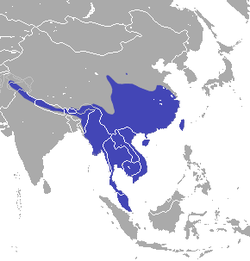 | Size: 4–18 cm (2–7 in) long, plus 4–11 cm (2–4 in) tail [6]
Habitat: Forest, shrubland, and grassland [19]
Diet: Invertebrates, small mammals, frogs, toads, and lizards [6] | LC
Unknown  [19] [19]
|
|---|
| Asian lesser white-toothed shrew  | C. shantungensis
Miller, 1901
- C. s. quelpartis
- C. s. shantungensis
| Eastern Asia
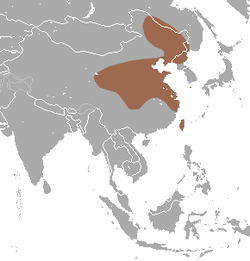 | Size: 4–18 cm (2–7 in) long, plus 4–11 cm (2–4 in) tail [6]
Habitat: Shrubland and grassland [20]
Diet: Invertebrates, small mammals, frogs, toads, and lizards [6] | LC
Unknown  [20] [20]
|
|---|
| Bailey's shrew
| C. baileyi
Osgood, 1936 | Ethiopia
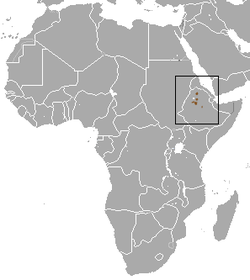 | Size: 4–18 cm (2–7 in) long, plus 4–11 cm (2–4 in) tail [6]
Habitat: Grassland [21]
Diet: Invertebrates, small mammals, frogs, toads, and lizards [6] | LC
Unknown  [21] [21]
|
|---|
| Bale shrew
| C. bottegoides
Hutterer & Yalden, 1990 | Ethiopia
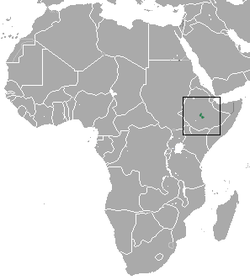 | Size: 4–6 cm (2 in) long, plus 4–5 cm (2 in) tail [22]
Habitat: Grassland and forest [23]
Diet: Invertebrates, small mammals, frogs, toads, and lizards [6] | EN
Unknown  [23] [23]
|
|---|
| Banka shrew
| C. vosmaeri
Jentink, 1888 | Bangka Island in Indonesia | Size: 4–18 cm (2–7 in) long, plus 4–11 cm (2–4 in) tail [6]
Habitat: Forest [24]
Diet: Invertebrates, small mammals, frogs, toads, and lizards [6] | DD
Unknown  [24] [24]
|
|---|
| Batak shrew
| C. batakorum
Hutterer, 2007 | Philippines
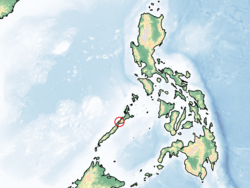 | Size: 4–18 cm (2–7 in) long, plus 4–11 cm (2–4 in) tail [6]
Habitat: Forest [25]
Diet: Invertebrates, small mammals, frogs, toads, and lizards [6] | DD
Unknown  [25] [25]
|
|---|
| Bates's shrew
| C. batesi
(Dollman, 1915) | Western Africa
 | Size: 4–18 cm (2–7 in) long, plus 4–11 cm (2–4 in) tail [6]
Habitat: Forest [26]
Diet: Invertebrates, small mammals, frogs, toads, and lizards [6] | LC
Unknown  [26] [26]
|
|---|
| Beccari's shrew
| C. beccarii
Dobson, 1886 | Sumatra
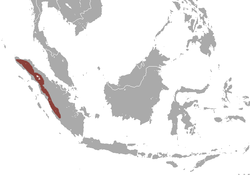 | Size: 4–18 cm (2–7 in) long, plus 4–11 cm (2–4 in) tail [6]
Habitat: Forest [27]
Diet: Invertebrates, small mammals, frogs, toads, and lizards [6] | LC
Unknown  [27] [27]
|
|---|
| Beletta shrew
| C. yaldeni
Lavrenchenko, Voyta, & Hutterer, 2016 | Ethiopia | Size: 4–18 cm (2–7 in) long, plus 4–11 cm (2–4 in) tail [6]
Habitat: Forest [28]
Diet: Invertebrates, small mammals, frogs, toads, and lizards [6] | DD
Unknown  [28] [28]
|
|---|
| Bicolored musk shrew
| C. fuscomurina
(Heuglin, 1865) | Sub-Saharan Africa
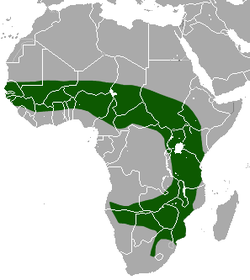 | Size: 4–8 cm (2–3 in) long, plus 2–5 cm (1–2 in) tail [29]
Habitat: Savanna, grassland, and desert [30]
Diet: Invertebrates, small mammals, frogs, toads, and lizards [6] | LC
Unknown  [30] [30]
|
|---|
| Bicolored shrew 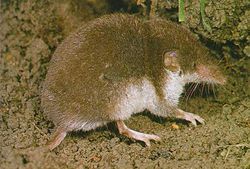 | C. leucodon
(Hermann, 1780) | Europe and western Asia
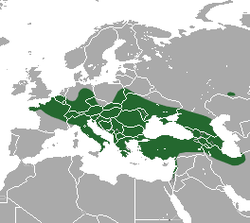 | Size: 6–9 cm (2–4 in) long, plus 2–5 cm (1–2 in) tail [31]
Habitat: Shrubland and grassland [32]
Diet: Small mammals, frogs, toads, lizards, and invertebrates [31] | LC
Unknown  [32] [32]
|
|---|
| Black-footed shrew  | C. nigripes
Miller & Hollister, 1921
- C. n. lipara
- C. n. nigripes
| Sulawesi island in Indonesia
| Size: 4–18 cm (2–7 in) long, plus 4–11 cm (2–4 in) tail [6]
Habitat: Forest
Diet: Invertebrates, small mammals, frogs, toads, and lizards [6] | LC
Unknown 
|
|---|
| Blackish white-toothed shrew
| C. nigricans
Bocage, 1889 | Angola
 | Size: 6–9 cm (2–4 in) long, plus 4–7 cm (2–3 in) tail [34]
Habitat: Unknown [35]
Diet: Invertebrates, small mammals, frogs, toads, and lizards [6] | LC
Unknown  [35] [35]
|
|---|
| Bornean shrew
| C. foetida
Peters, 1870
- C. f. doriae
- C. f. foetida
- C. f. kelabit
| Borneo
 | Size: 4–18 cm (2–7 in) long, plus 4–11 cm (2–4 in) tail [6]
Habitat: Forest [36]
Diet: Invertebrates, small mammals, frogs, toads, and lizards [6] | LC
Unknown  [36] [36]
|
|---|
| Bottego's shrew
| C. bottegi
Thomas, 1898 | Ethiopia
 | Size: 4–6 cm (2 in) long, plus 2–3 cm (1 in) tail [37]
Habitat: Unknown [38]
Diet: Invertebrates, small mammals, frogs, toads, and lizards [6] | DD
Unknown  [38] [38]
|
|---|
| Buettikofer's shrew
| C. buettikoferi
Jentink, 1888 | West-central Africa
 | Size: 7–10 cm (3–4 in) long, plus 5–7 cm (2–3 in) tail [39]
Habitat: Forest
Diet: Invertebrates, small mammals, frogs, toads, and lizards [6] | LC
Unknown 
|
|---|
| Butiaba naked-tailed shrew
| C. littoralis
Heller, 1910 | Central Africa
 | Size: 8–10 cm (3–4 in) long, plus 6–8 cm (2–3 in) tail [41]
Habitat: Forest [42]
Diet: Invertebrates, small mammals, frogs, toads, and lizards [6] | LC
Unknown  [42] [42]
|
|---|
| Cameroonian shrew
| C. picea
Sanderson, 1940 | West-central Africa
 | Size: 4–18 cm (2–7 in) long, plus 4–11 cm (2–4 in) tail [6]
Habitat: Forest and grassland [43]
Diet: Invertebrates, small mammals, frogs, toads, and lizards [6] | EN
Unknown  [43] [43]
|
|---|
| Canarian shrew  | C. canariensis
Hutterer, López-Jurado, & Vogel, 1987 | Canary Islands
 | Size: 4–18 cm (2–7 in) long, plus 4–11 cm (2–4 in) tail [6]
Habitat: Coastal marine, desert, and shrubland [44]
Diet: Snails and insects [44] | EN
Unknown  [44] [44]
|
|---|
| Caspian shrew
| C. caspica
Thomas, 1907 | Iran and Azerbaijan
 | Size: 4–18 cm (2–7 in) long, plus 4–11 cm (2–4 in) tail [6]
Habitat: Unknown [45]
Diet: Invertebrates, small mammals, frogs, toads, and lizards [6] | DD
Unknown  [45] [45]
|
|---|
| Chinese white-toothed shrew
| C. rapax
Allen, 1923
- C. r. kurodai
- C. r. lutaoensis
- C. r. rapax
- C. r. tadae
| Eastern Asia | Size: 4–18 cm (2–7 in) long, plus 4–11 cm (2–4 in) tail [6]
Habitat: Unknown [46]
Diet: Invertebrates, small mammals, frogs, toads, and lizards [6] | DD
Unknown  [46] [46]
|
|---|
| Christmas Island shrew†
| C. trichura
Dobson, 1889 | Christmas Island
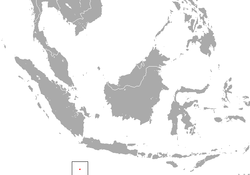 | Size: 4–18 cm (2–7 in) long, plus 4–11 cm (2–4 in) tail [6]
Habitat: Forest [47]
Diet: Invertebrates, small mammals, frogs, toads, and lizards [6] | EX
0  [47] [47]
|
|---|
| Cinderella shrew
| C. cinderella
Thomas, 1911 | Western Africa
 | Size: 5–7 cm (2–3 in) long, plus 4–5 cm (2–2 in) tail [48]
Habitat: Savanna [49]
Diet: Invertebrates, small mammals, frogs, toads, and lizards [6] | LC
Unknown  [49] [49]
|
|---|
| Congo white-toothed shrew
| C. congobelgica
Hollister, 1916 | Central Africa
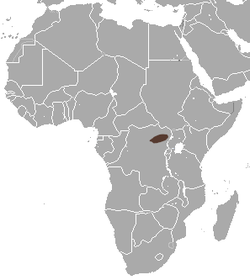 | Size: 4–18 cm (2–7 in) long, plus 4–11 cm (2–4 in) tail [6]
Habitat: Forest [50]
Diet: Invertebrates, small mammals, frogs, toads, and lizards [6] | LC
Unknown  [50] [50]
|
|---|
| Cranbrook's white-toothed shrew
| C. cranbrooki
Jenkins, Lunde, & Moncrieff, 2009 | Northern Myanmar | Size: 4–18 cm (2–7 in) long, plus 4–11 cm (2–4 in) tail [6]
Habitat: Forest [51]
Diet: Invertebrates, small mammals, frogs, toads, and lizards [6] | DD
Unknown  [51] [51]
|
|---|
| Cretan shrew
| C. zimmermanni
Wettstein, 1953 | Island of Crete in Greece
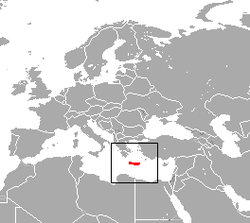 | Size: 4–18 cm (2–7 in) long, plus 4–11 cm (2–4 in) tail [6]
Habitat: Unknown and rocky areas [52]
Diet: Invertebrates, small mammals, frogs, toads, and lizards [6] | EN
Unknown  [52] [52]
|
|---|
| Crosse's shrew
| C. crossei
Thomas, 1895 | Western Africa
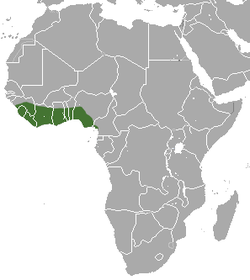 | Size: 6–7 cm (2–3 in) long, plus 4–6 cm (2 in) tail [53]
Habitat: Forest [54]
Diet: Invertebrates, small mammals, frogs, toads, and lizards [6] | LC
Unknown  [54] [54]
|
|---|
| Cyrenaica shrew
| C. aleksandrisi
Vesmanis, 1977 | Northern Libya
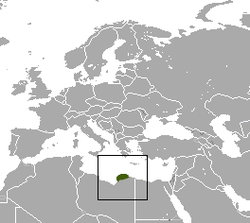 | Size: 5–7 cm (2–3 in) long, plus 3–5 cm (1–2 in) tail [55]
Habitat: Shrubland [56]
Diet: Invertebrates, small mammals, frogs, toads, and lizards [6] | LC
Unknown  [56] [56]
|
|---|
| Dent's shrew  | C. denti
Dollman, 1915 | Western and central Africa
 | Size: About 6 cm (2 in) long, plus 5 cm (2 in) tail [57]
Habitat: Forest and savanna [58]
Diet: Invertebrates, small mammals, frogs, toads, and lizards [6] | LC
Unknown  [58] [58]
|
|---|
| Desert musk shrew
| C. smithii
Thomas, 1895
- C. s. debalsaci
- C. s. smithii
| Western and Eastern Africa
 | Size: 6–9 cm (2–4 in) long, plus 3–6 cm (1–2 in) tail [59]
Habitat: Savanna [60]
Diet: Invertebrates, small mammals, frogs, toads, and lizards [6] | LC
Unknown  [60] [60]
|
|---|
| Desperate shrew
| C. desperata
Hutterer, Jenkins, & Verheyen, 1991 | Tanzania
 | Size: 8–11 cm (3–4 in) long, plus about 7 cm (3 in) tail [61]
Habitat: Forest [62]
Diet: Invertebrates, small mammals, frogs, toads, and lizards [6] | VU
Unknown  [62] [62]
|
|---|
| Dhofar shrew
| C. dhofarensis
(Hutterer, 1988) | Yemen and Oman | Size: 4–18 cm (2–7 in) long, plus 4–11 cm (2–4 in) tail [6]
Habitat: Unknown [63]
Diet: Invertebrates, small mammals, frogs, toads, and lizards [6] | DD
Unknown  [63] [63]
|
|---|
| Doucet's musk shrew
| C. douceti
Heim de Balsac, 1958 | Western Africa
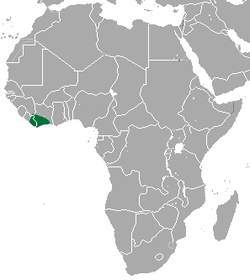 | Size: 4–18 cm (2–7 in) long, plus 4–11 cm (2–4 in) tail [6]
Habitat: Forest [64]
Diet: Invertebrates, small mammals, frogs, toads, and lizards [6] | LC
Unknown  [64] [64]
|
|---|
| Dsinezumi shrew 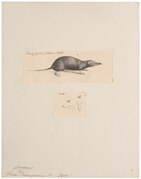 | C. dsinezumi
(Temminck, 1842) | Japan
 | Size: 4–18 cm (2–7 in) long, plus 4–11 cm (2–4 in) tail [6]
Habitat: Shrubland, grassland, and inland wetlands [65]
Diet: Invertebrates, small mammals, frogs, toads, and lizards [6] | LC
Unknown  [65] [65]
|
|---|
| East African highland shrew
| C. allex
Osgood, 1910 | Kenya and Tanzania
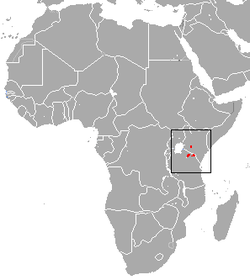 | Size: 5–7 cm (2–3 in) long, plus 4–6 cm (2 in) tail [66]
Habitat: Grassland and inland wetlands [67]
Diet: Invertebrates, small mammals, frogs, toads, and lizards [6] | LC
Unknown  [67] [67]
|
|---|
| Egyptian pygmy shrew
| C. religiosa
(Geoffroy, 1827) | Northern Egypt
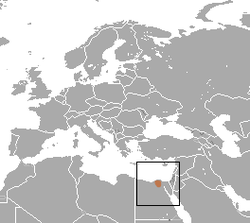 | Size: 4–7 cm (2–3 in) long, plus 2–4 cm (1–2 in) tail [68]
Habitat: [69]
Diet: Invertebrates, small mammals, frogs, toads, and lizards [6] | DD
Unknown  [69] [69]
|
|---|
| Eisentraut's shrew
| C. eisentrauti
Heim de Balsac, 1957 | Cameroon
 | Size: 4–18 cm (2–7 in) long, plus 4–11 cm (2–4 in) tail [6]
Habitat: Grassland and forest [70]
Diet: Invertebrates, small mammals, frogs, toads, and lizards [6] | VU
Unknown  [70] [70]
|
|---|
| Elgon shrew
| C. elgonius
Osgood, 1910 | Kenya and Tanzania
 | Size: 4–18 cm (2–7 in) long, plus 4–11 cm (2–4 in) tail [6]
Habitat: Forest [71]
Diet: Invertebrates, small mammals, frogs, toads, and lizards [6] | LC
Unknown  [71] [71]
|
|---|
| Elongated shrew
| C. elongata
Miller & Hollister, 1921 | Sulawesi island in Indonesia
 | Size: 4–18 cm (2–7 in) long, plus 4–11 cm (2–4 in) tail [6]
Habitat: Forest and shrubland [72]
Diet: Invertebrates, small mammals, frogs, toads, and lizards [6] | LC
Unknown  [72] [72]
|
|---|
| Fingui white-toothed shrew
| C. fingui
Ceríaco et al., 2015 | Príncipe in São Tomé and Príncipe | Size: 4–18 cm (2–7 in) long, plus 4–11 cm (2–4 in) tail [6]
Habitat: Forest [73]
Diet: Invertebrates, small mammals, frogs, toads, and lizards [6] | DD
Unknown  [73] [73]
|
|---|
| Fischer's shrew
| C. fischeri
Pagenstecher, 1885 | Kenya and Tanzania
 | Size: 6–10 cm (2–4 in) long, plus 4–6 cm (2 in) tail [74]
Habitat: Savanna
Diet: Invertebrates, small mammals, frogs, toads, and lizards [6] | DD
Unknown 
|
|---|
| Flat-headed shrew
| C. planiceps
Heller, 1910 | West-central Africa
 | Size: 4–18 cm (2–7 in) long, plus 4–11 cm (2–4 in) tail [6]
Habitat: Inland wetlands [76]
Diet: Invertebrates, small mammals, frogs, toads, and lizards [6] | DD
Unknown  [76] [76]
|
|---|
| Flower's shrew
| C. floweri
Dollman, 1915 | Northern Egypt
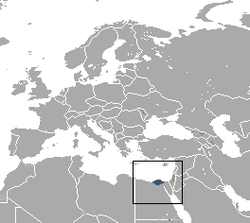 | Size: 5–8 cm (2–3 in) long, plus 5–6 cm (2–2 in) tail [77]
Habitat: Artificial terrain
Diet: Invertebrates, small mammals, frogs, toads, and lizards [6] | DD
Unknown 
|
|---|
| Fox's shrew
| C. foxi
Dollman, 1915 | Western and central Africa
 | Size: 9–12 cm (4–5 in) long, plus 5–8 cm (2–3 in) tail [79]
Habitat: Savanna and forest [80]
Diet: Invertebrates, small mammals, frogs, toads, and lizards [6] | LC
Unknown  [80] [80]
|
|---|
| Fraser's musk shrew
| C. poensis
(Fraser, 1843) | Western Africa
 | Size: 7–10 cm (3–4 in) long, plus 4–7 cm (2–3 in) tail [81]
Habitat: Shrubland and forest [82]
Diet: Arthropods and other invertebrates [81] | LC
Unknown  [82] [82]
|
|---|
| Gathorne's shrew
| C. gathornei
Jenkins, 2013 | Himalayas in India | Size: 4–18 cm (2–7 in) long, plus 4–11 cm (2–4 in) tail [6]
Habitat: Shrubland and grassland [83]
Diet: Invertebrates, small mammals, frogs, toads, and lizards [6] | DD
Unknown  [83] [83]
|
|---|
| Glass's shrew
| C. glassi
Heim de Balsac, 1966 | Ethiopia
 | Size: 6–9 cm (2–4 in) long, plus 4–6 cm (2 in)tail [84]
Habitat: Shrubland, grassland, and inland wetlands [85]
Diet: Invertebrates, small mammals, frogs, toads, and lizards [6] | NT
Unknown  [85] [85]
|
|---|
| Gmelin's white-toothed shrew
| C. gmelini
Pallas, 1811 | Central Asia
 | Size: 4–18 cm (2–7 in) long, plus 4–11 cm (2–4 in) tail [6]
Habitat: Shrubland and grassland [86]
Diet: Invertebrates, small mammals, frogs, toads, and lizards [6] | LC
Unknown  [86] [86]
|
|---|
| Goliath shrew
| C. goliath
Thomas, 1906 | Central Africa
 | Size: 15–18 cm (6–7 in) long, plus 10–14 cm (4–6 in) tail [87]
Habitat: Forest [88]
Diet: Invertebrates, small mammals, frogs, toads, and lizards [6] | LC
Unknown  [88] [88]
|
|---|
| Gracile naked-tailed shrew
| C. maurisca
Thomas, 1904 | Central Africa
 | Size: 7–10 cm (3–4 in) long, plus 6–8 cm (2–3 in) tail [89]
Habitat: Inland wetlands and forest [90]
Diet: Invertebrates, small mammals, frogs, toads, and lizards [6] | LC
Unknown  [90] [90]
|
|---|
| Grasse's shrew
| C. grassei
Brosset, Dubost, & Heim de Balsac, 1965 | West-central Africa
 | Size: 7–9 cm (3–4 in) long, plus 6–8 cm (2–3 in) tail [91]
Habitat: Forest [92]
Diet: Invertebrates, small mammals, frogs, toads, and lizards [6] | LC
Unknown  [92] [92]
|
|---|
| Greater Mindanao shrew
| C. grandis
Miller, 1911 | Philippines
 | Size: 4–18 cm (2–7 in) long, plus 4–11 cm (2–4 in) tail [6]
Habitat: Forest [93]
Diet: Invertebrates, small mammals, frogs, toads, and lizards [6] | DD
Unknown  [93] [93]
|
|---|
| Greater red musk shrew  | C. flavescens
(Geoffroy, 1827) | Southern Africa
 | Size: 8–12 cm (3–5 in) long, plus 3–6 cm (1–2 in) tail [94]
Habitat: Savanna and grassland [95]
Diet: Invertebrates, small mammals, frogs, toads, and lizards [6] | LC
Unknown  [95] [95]
|
|---|
| Greater white-toothed shrew 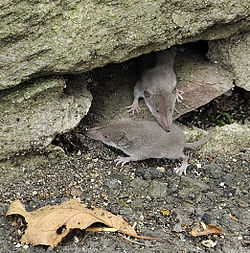 | C. russula
(Hermann, 1780) | Europe and northwestern Africa
 | Size: 6–9 cm (2–4 in) long, plus 3–5 cm (1–2 in) tail [96]
Habitat: Shrubland [97]
Diet: Invertebrates, as well as small mammals and small lizards [96] | LC
Unknown  [97] [97]
|
|---|
| Greenwood's shrew
| C. greenwoodi
Heim de Balsac, 1966 | Somalia
 | Size: 4–18 cm (2–7 in) long, plus 4–11 cm (2–4 in) tail [6]
Habitat: Forest, savanna, and shrubland [98]
Diet: Invertebrates, small mammals, frogs, toads, and lizards [6] | LC
Unknown  [98] [98]
|
|---|
| Guramba shrew
| C. phaeura
Osgood, 1936 | Ethiopia
 | Size: 4–18 cm (2–7 in) long, plus 4–11 cm (2–4 in) tail [6]
Habitat: Forest [99]
Diet: Invertebrates, small mammals, frogs, toads, and lizards [6] | EN
Unknown  [99] [99]
|
|---|
| Guy's shrew
| C. guy
Jenkins, Lunde, & Moncrieff, 2009 | Vietnam | Size: 4–18 cm (2–7 in) long, plus 4–11 cm (2–4 in) tail [6]
Habitat: Forest [100]
Diet: Invertebrates, small mammals, frogs, toads, and lizards [6] | DD
Unknown  [100] [100]
|
|---|
| Güldenstädt's shrew
| C. gueldenstaedtii
(Pallas, 1811) | Europe and western Asia | Size: 4–18 cm (2–7 in) long, plus 4–11 cm (2–4 in) tail [6]
Habitat: Shrubland, grassland, inland wetlands, rocky areas, intertidal marine, and coastal marine [101]
Diet: Insects, as well as molluscs, amphipods, annelids, and small vertebrates [101] | LC
Unknown  [101] [101]
|
|---|
| Hainan Island shrew
| C. wuchihensis
Sung, 1966 | Southern China and northern Vietnam | Size: 4–18 cm (2–7 in) long, plus 4–11 cm (2–4 in) tail [6]
Habitat: Forest [102]
Diet: Invertebrates, small mammals, frogs, toads, and lizards [6] | DD
Unknown  [102] [102]
|
|---|
| Harenna shrew
| C. harenna
Hutterer & Yalden, 1990 | Ethiopia
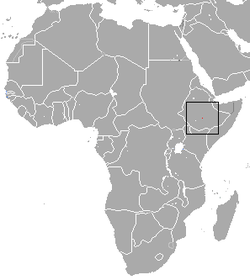 | Size: 4–18 cm (2–7 in) long, plus 4–11 cm (2–4 in) tail [6]
Habitat: Forest [103]
Diet: Invertebrates, small mammals, frogs, toads, and lizards [6] | CR
Unknown  [103] [103]
|
|---|
| Heather shrew
| C. erica
Dollman, 1915 | Angola
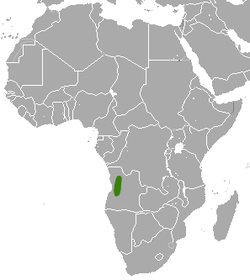 | Size: About 10 cm (4 in) long, plus 5 cm (2 in) tail [104]
Habitat: Unknown [105]
Diet: Invertebrates, small mammals, frogs, toads, and lizards [6] | DD
Unknown  [105] [105]
|
|---|
| Hildegarde's shrew
| C. hildegardeae
Thomas, 1904 | Central Africa
 | Size: 6–8 cm (2–3 in) long, plus 3–6 cm (1–2 in) tail [106]
Habitat: Forest [107]
Diet: Invertebrates, small mammals, frogs, toads, and lizards [6] | LC
Unknown  [107] [107]
|
|---|
| Hill's shrew
| C. hilliana
Jenkins & Smith, 1995 | Thailand and Laos
 | Size: 4–18 cm (2–7 in) long, plus 4–11 cm (2–4 in) tail [6]
Habitat: Forest and shrubland [108]
Diet: Invertebrates, small mammals, frogs, toads, and lizards [6] | DD
Unknown  [108] [108]
|
|---|
| Horsfield's shrew
| C. horsfieldii
(Tomes, 1856) | Scattered southern Asia
 | Size: 4–18 cm (2–7 in) long, plus 4–11 cm (2–4 in) tail [6]
Habitat: Forest [109]
Diet: Invertebrates, small mammals, frogs, toads, and lizards [6] | DD
Unknown  [109] [109]
|
|---|
| Hun shrew
| C. attila
Dollman, 1915 | Central Africa
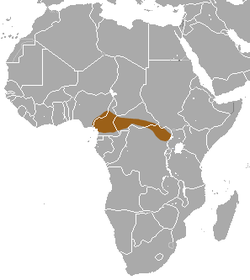 | Size: 4–18 cm (2–7 in) long, plus 4–11 cm (2–4 in) tail [6]
Habitat: Forest [110]
Diet: Invertebrates, small mammals, frogs, toads, and lizards [6] | LC
Unknown  [110] [110]
|
|---|
| Hutan shrew
| C. hutanis
Ruedi & Vogel, 1995 | Sumatra island in Indonesia
 | Size: 4–18 cm (2–7 in) long, plus 4–11 cm (2–4 in) tail [6]
Habitat: Forest [111]
Diet: Invertebrates, small mammals, frogs, toads, and lizards [6] | LC
Unknown  [111] [111]
|
|---|
| Indochinese shrew
| C. indochinensis
Kloss, 1922 | Southeastern Asia
 | Size: 4–18 cm (2–7 in) long, plus 4–11 cm (2–4 in) tail [6]
Habitat: Forest [112]
Diet: Invertebrates, small mammals, frogs, toads, and lizards [6] | LC
Unknown  [112] [112]
|
|---|
| Iranian shrew
| C. susiana
Redding & Lay, 1978 | Iran
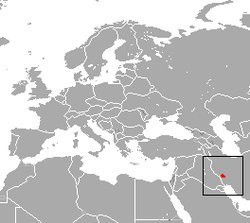 | Size: 4–18 cm (2–7 in) long, plus 4–11 cm (2–4 in) tail [6]
Habitat: Unknown [113]
Diet: Invertebrates, small mammals, frogs, toads, and lizards [6] | DD
Unknown  [113] [113]
|
|---|
| Jackass shrew
| C. arispa
Spitzenberger, 1971 | Turkey
 | Size: 4–18 cm (2–7 in) long, plus 4–11 cm (2–4 in) tail [6]
Habitat: Rocky areas [114]
Diet: Invertebrates, small mammals, frogs, toads, and lizards [6] | LC
Unknown  [114] [114]
|
|---|
| Jackson's shrew
| C. jacksoni
Thomas, 1904 | East-central Africa
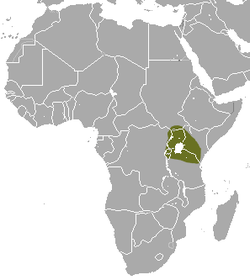 | Size: 5–9 cm (2–4 in) long, plus 4–7 cm (2–3 in) tail [115]
Habitat: Forest [116]
Diet: Invertebrates, small mammals, frogs, toads, and lizards [6] | LC
Unknown  [116] [116]
|
|---|
| Javan ghost shrew
| C. umbra
Demos, Achmadi, Handika, Maharadatunkamsi, Rowe, & Esselstyn, 2016 | Java island in Indonesia | Size: 4–18 cm (2–7 in) long, plus 4–11 cm (2–4 in) tail [6]
Habitat: Forest [117]
Diet: Invertebrates, small mammals, frogs, toads, and lizards [6] | NT
Unknown  [117] [117]
|
|---|
| Javanese shrew
| C. maxi
Sody, 1936 | Indonesia and East Timor
 | Size: 4–18 cm (2–7 in) long, plus 4–11 cm (2–4 in) tail [6]
Habitat: Forest [118]
Diet: Invertebrates, small mammals, frogs, toads, and lizards [6] | LC
Unknown  [118] [118]
|
|---|
| Jenkins's shrew
| C. jenkinsi
Chakraborty, 1978 | South Andaman Island in India
 | Size: 4–18 cm (2–7 in) long, plus 4–11 cm (2–4 in) tail [6]
Habitat: Forest [119]
Diet: Invertebrates, small mammals, frogs, toads, and lizards [6] | CR
Unknown  [119] [119]
|
|---|
| Jouvenet's shrew
| C. jouvenetae
Heim de Balsac, 1958 | Western Africa
 | Size: 6–9 cm (2–4 in) long, plus 4–7 cm (2–3 in) tail [120]
Habitat: Forest [121]
Diet: Invertebrates, small mammals, frogs, toads, and lizards [6] | LC
Unknown  [121] [121]
|
|---|
| Kashmir white-toothed shrew
| C. pullata
Miller, 1911 | Northern India and Pakistan
 | Size: 4–18 cm (2–7 in) long, plus 4–11 cm (2–4 in) tail [6]
Habitat: Unknown [122]
Diet: Invertebrates, small mammals, frogs, toads, and lizards [6] | LC
Unknown  [122] [122]
|
|---|
| Katinka's shrew
| C. katinka
Bate, 1937 | Western Asia
 | Size: 4–18 cm (2–7 in) long, plus 4–11 cm (2–4 in) tail [6]
Habitat: Unknown [123]
Diet: Invertebrates, small mammals, frogs, toads, and lizards [6] | DD
Unknown  [123] [123]
|
|---|
| Kilimanjaro shrew
| C. monax
Thomas, 1910 |
 | Size: 4–18 cm (2–7 in) long, plus 4–11 cm (2–4 in) tail [6]
Habitat: Forest [124]
Diet: Invertebrates, small mammals, frogs, toads, and lizards [6] | DD
Unknown  [124] [124]
|
|---|
| Kinabalu shrew
| C. baluensis
Thomas, 1898 | Northern Borneo
 | Size: 4–18 cm (2–7 in) long, plus 4–11 cm (2–4 in) tail [6]
Habitat: Forest, shrubland, and grassland [125]
Diet: Invertebrates, small mammals, frogs, toads, and lizards [6] | LC
Unknown  [125] [125]
|
|---|
| Kivu long-haired shrew
| C. lanosa
Heim de Balsac, 1968 | Central Africa
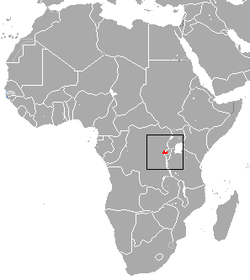 | Size: 4–18 cm (2–7 in) long, plus 4–11 cm (2–4 in) tail [6]
Habitat: Forest and inland wetlands [126]
Diet: Invertebrates, small mammals, frogs, toads, and lizards [6] | VU
Unknown  [126] [126]
|
|---|
| Kivu shrew
| C. kivuana
Heim de Balsac, 1968 | Central Africa
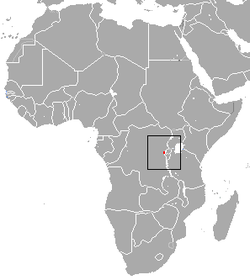 | Size: 6–9 cm (2–4 in) long, plus 6–8 cm (2–3 in) tail [127]
Habitat: Forest and inland wetlands [128]
Diet: Invertebrates, small mammals, frogs, toads, and lizards [6] | NT
Unknown  [128] [128]
|
|---|
| Lamotte's shrew
| C. lamottei
Heim de Balsac, 1968 | Western Africa
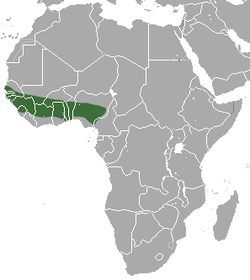 | Size: 8–9 cm (3–4 in) long, plus 3–6 cm (1–2 in) tail [127]
Habitat: Forest and savanna [129]
Diet: Invertebrates, small mammals, frogs, toads, and lizards [6] | LC
Unknown  [129] [129]
|
|---|
| Large-headed forest shrew
| C. grandiceps
Hutterer, 1983 | Western Africa
 | Size: 9–12 cm (4–5 in) long, plus 5–8 cm (2–3 in) tail [130]
Habitat: Forest [131]
Diet: Invertebrates, small mammals, frogs, toads, and lizards [6] | LC
Unknown  [131] [131]
|
|---|
| Latona's shrew
| C. latona
Hollister, 1916 | Democratic Republic of the Congo
 | Size: 4–18 cm (2–7 in) long, plus 4–11 cm (2–4 in) tail [6]
Habitat: Forest [132]
Diet: Invertebrates, small mammals, frogs, toads, and lizards [6] | LC
Unknown  [132] [132]
|
|---|
| Lesser Ryukyu shrew
| C. watasei
Kuroda, 1924 | Southern Japan
 | Size: 4–18 cm (2–7 in) long, plus 4–11 cm (2–4 in) tail [6]
Habitat: Shrubland, grassland, and inland wetlands [133]
Diet: Invertebrates, small mammals, frogs, toads, and lizards [6] | LC
Unknown  [133] [133]
|
|---|
| Lesser gray-brown musk shrew
| C. silacea
Thomas, 1895 | Southern Africa
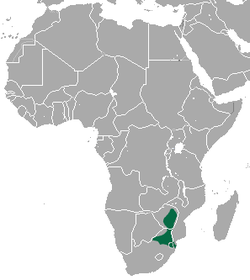 | Size: 6–8 cm (2–3 in) long, plus 4–6 cm (2 in) tail [134]
Habitat: Rocky areas, grassland, shrubland, and savanna [135]
Diet: Invertebrates, small mammals, frogs, toads, and lizards [6] | LC
Unknown  [135] [135]
|
|---|
| Lesser red musk shrew  | C. hirta
Peters, 1852 | Southern and southeastern Africa
 | Size: 6–10 cm (2–4 in) long, plus 3–6 cm (1–2 in) tail [136]
Habitat: Savanna, grassland, and desert [137]
Diet: Invertebrates, small mammals, frogs, toads, and lizards [6] | LC
Unknown  [137] [137]
|
|---|
| Lesser rock shrew
| C. serezkyensis
Laptev, 1929 | Western Asia
 | Size: 4–18 cm (2–7 in) long, plus 4–11 cm (2–4 in) tail [6]
Habitat: Unknown [138]
Diet: Invertebrates, small mammals, frogs, toads, and lizards [6] | LC
Unknown  [138] [138]
|
|---|
| Lesser white-toothed shrew  | C. suaveolens
(Pallas, 1811) | Europe and Asia
 | Size: 4–18 cm (2–7 in) long, plus 4–11 cm (2–4 in) tail [6]
Habitat: Forest, shrubland, grassland, rocky areas, and coastal/supratidal marine [139]
Diet: Invertebrates, small mammals, frogs, toads, and lizards [6] | LC
Unknown  [139] [139]
|
|---|
| Long-footed shrew
| C. crenata
Brosset, Dubost, & Heim de Balsac, 1965 | West-central Africa
| Size: 4–18 cm (2–7 in) long, plus 4–11 cm (2–4 in) tail [6]
Habitat: Forest
Diet: Invertebrates, small mammals, frogs, toads, and lizards [6] | LC
Unknown 
|
|---|
| Long-tailed musk shrew
| C. dolichura
Peters, 1876 | Central Africa
 | Size: 6–7 cm (2–3 in) long, plus 7–8 cm (3 in) tail [141]
Habitat: Forest [142]
Diet: Invertebrates, small mammals, frogs, toads, and lizards [6] | LC
Unknown  [142] [142]
|
|---|
| Lucina's shrew
| C. lucina
Dippenaar, 1980 | Ethiopia
 | Size: 8–10 cm (3–4 in) long, plus 4–6 cm (2 in) tail [143]
Habitat: Grassland and inland wetlands [144]
Diet: Invertebrates, small mammals, frogs, toads, and lizards [6] | VU
Unknown  [144] [144]
|
|---|
| Ludia's shrew
| C. ludia
Hollister, 1916 | Central Africa
 | Size: 6–7 cm (2–3 in) long, plus 5–6 cm (2–2 in) tail [145]
Habitat: Forest [146]
Diet: Invertebrates, small mammals, frogs, toads, and lizards [6] | LC
Unknown  [146] [146]
|
|---|
| Luzon shrew
| C. grayi
Dobson, 1890 | Philippines
 | Size: 4–18 cm (2–7 in) long, plus 4–11 cm (2–4 in) tail [6]
Habitat: Forest [147]
Diet: Invertebrates, small mammals, frogs, toads, and lizards [6] | LC
Unknown  [147] [147]
|
|---|
| Lwiro shrew
| C. lwiroensis
Peterhans & Hutterer, 2013 | Democratic Republic of the Congo | Size: 4–18 cm (2–7 in) long, plus 4–11 cm (2–4 in) tail [6]
Habitat: Forest [148]
Diet: Invertebrates, small mammals, frogs, toads, and lizards [6] | DD
Unknown  [148] [148]
|
|---|
| MacArthur's shrew
| C. macarthuri
St. Leger, 1934 | Eastern Africa
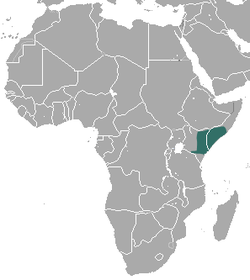 | Size: 4–18 cm (2–7 in) long, plus 4–11 cm (2–4 in) tail [6]
Habitat: Savanna
Diet: Invertebrates, small mammals, frogs, toads, and lizards [6] | LC
Unknown 
|
|---|
| MacMillan's shrew
| C. macmillani
Dollman, 1915 | Ethiopia
 | Size: 4–18 cm (2–7 in) long, plus 4–11 cm (2–4 in) tail [6]
Habitat: Forest and savanna [150]
Diet: Invertebrates, small mammals, frogs, toads, and lizards [6] | NT
Unknown  [150] [150]
|
|---|
| Makwassie musk shrew
| C. maquassiensis
Roberts, 1946 | Southern Africa
 | Size: 5–8 cm (2–3 in) long, plus 4–5 cm (2–2 in) tail [151]
Habitat: Grassland and rocky areas [152]
Diet: Invertebrates, small mammals, frogs, toads, and lizards [6] | LC
Unknown  [152] [152]
|
|---|
| Malayan shrew
| C. malayana
Robinson & Kloss, 1911 | Malaysia
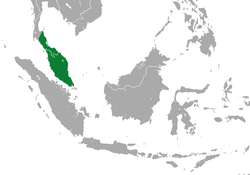 | Size: 4–18 cm (2–7 in) long, plus 4–11 cm (2–4 in) tail [6]
Habitat: Forest [153]
Diet: Invertebrates, small mammals, frogs, toads, and lizards [6] | LC
Unknown  [153] [153]
|
|---|
| Mamfe shrew
| C. virgata
Sanderson, 1940 | West-central Africa | Size: 4–18 cm (2–7 in) long, plus 4–11 cm (2–4 in) tail [6]
Habitat: Forest and grassland [154]
Diet: Invertebrates, small mammals, frogs, toads, and lizards [6] | LC
Unknown  [154] [154]
|
|---|
| Manenguba shrew
| C. manengubae
Hutterer, 1982 | West-central Africa
 | Size: 7–9 cm (3–4 in) long, plus 6–7 cm (2–3 in) tail [151]
Habitat: Forest, shrubland, and grassland [155]
Diet: Invertebrates, small mammals, frogs, toads, and lizards [6] | VU
Unknown  [155] [155]
|
|---|
| Mauritanian shrew
| C. lusitania
Dollman, 1915 | Western and eastern Africa
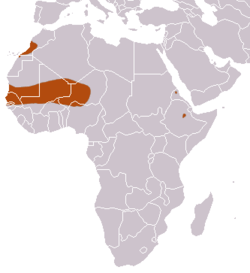 | Size: 4–7 cm (2–3 in) long, plus 2–4 cm (1–2 in) tail [156]
Habitat: Savanna and shrubland [157]
Diet: Invertebrates, small mammals, frogs, toads, and lizards [6] | LC
Unknown  [157] [157]
|
|---|
| Mduma's shrew
| C. mdumai
Stanley, Hutterer, Giarla, & Esselstyn, 2015 | Tanzania | Size: 4–18 cm (2–7 in) long, plus 4–11 cm (2–4 in) tail [6]
Habitat: Forest [158]
Diet: Invertebrates, small mammals, frogs, toads, and lizards [6] | EN
Unknown  [158] [158]
|
|---|
| Mindanao shrew  | C. beatus
Miller, 1910 | Philippines
 | Size: 4–18 cm (2–7 in) long, plus 4–11 cm (2–4 in) tail [6]
Habitat: Forest [159]
Diet: Invertebrates, small mammals, frogs, toads, and lizards [6] | LC
Unknown  [159] [159]
|
|---|
| Mindoro shrew
| C. mindorus
Miller, 1910 | Philippines
 | Size: 4–18 cm (2–7 in) long, plus 4–11 cm (2–4 in) tail [6]
Habitat: Forest [160]
Diet: Invertebrates, small mammals, frogs, toads, and lizards [6] | DD
Unknown  [160] [160]
|
|---|
| Montane white-toothed shrew
| C. montis
Thomas, 1906 | Eastern Africa
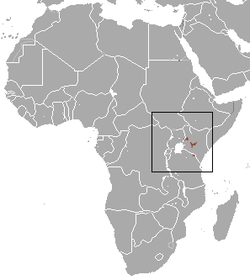 | Size: 4–18 cm (2–7 in) long, plus 4–11 cm (2–4 in) tail [6]
Habitat: Forest, shrubland, and grassland [161]
Diet: Invertebrates, small mammals, frogs, toads, and lizards [6] | LC
Unknown  [161] [161]
|
|---|
| Moonshine shrew
| C. luna
Dollman, 1910 | Southeastern Africa
 | Size: 6–11 cm (2–4 in) long, plus 3–7 cm (1–3 in) tail [156]
Habitat: Forest [162]
Diet: Invertebrates, small mammals, frogs, toads, and lizards [6] | LC
Unknown  [162] [162]
|
|---|
| Mossy forest shrew
| C. musseri
Ruedi & Vogel, 1995 | Sulawesi island in Indonesia
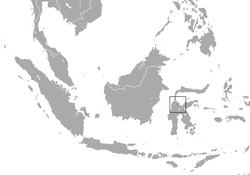 | Size: 4–18 cm (2–7 in) long, plus 4–11 cm (2–4 in) tail [6]
Habitat: Forest [163]
Diet: Invertebrates, small mammals, frogs, toads, and lizards [6] | VU
Unknown  [163] [163]
|
|---|
| Mount Nimba giant forest shrew
| C. nimbasilvanus
Hutterer, 2003 | Western Africa | Size: 4–18 cm (2–7 in) long, plus 4–11 cm (2–4 in) tail [6]
Habitat: Forest [164]
Diet: Invertebrates, small mammals, frogs, toads, and lizards [6] | LC
Unknown  [164] [164]
|
|---|
| Munissi's shrew
| C. munissii
Stanley, Hutterer, Giarla, & Esselstyn, 2015 | Tanzania | Size: 4–18 cm (2–7 in) long, plus 4–11 cm (2–4 in) tail [6]
Habitat: Forest [165]
Diet: Invertebrates, small mammals, frogs, toads, and lizards [6] | LC
Unknown  [165] [165]
|
|---|
| Narrow-headed shrew
| C. stenocephala
Heim de Balsac & Dieterlen, 1979 | Central Africa
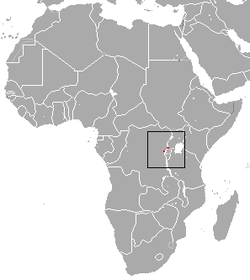 | Size: 8–11 cm (3–4 in) long, plus 6–9 cm (2–4 in) tail [166]
Habitat: Inland wetlands [167]
Diet: Invertebrates, small mammals, frogs, toads, and lizards [6] | VU
Unknown  [167] [167]
|
|---|
| Negev shrew
| C. ramona
Ivanitskaya, Shenbrot, & Nevo, 1996 | Israel
 | Size: 4–18 cm (2–7 in) long, plus 4–11 cm (2–4 in) tail [6]
Habitat: Desert [168]
Diet: Invertebrates, small mammals, frogs, toads, and lizards [6] | LC
Unknown  [168] [168]
|
|---|
| Negros shrew
| C. negrina
Rabor, 1952 | Philippines
 | Size: 4–18 cm (2–7 in) long, plus 4–11 cm (2–4 in) tail [6]
Habitat: Forest [169]
Diet: Invertebrates, small mammals, frogs, toads, and lizards [6] | EN
Unknown  [169] [169]
|
|---|
| Nicobar shrew
| C. nicobarica
Miller, 1902 | Great Nicobar Island in India
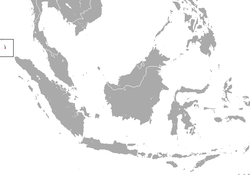 | Size: 4–18 cm (2–7 in) long, plus 4–11 cm (2–4 in) tail [6]
Habitat: Forest [170]
Diet: Invertebrates, small mammals, frogs, toads, and lizards [6] | CR
Unknown  [170] [170]
|
|---|
| Nigerian shrew
| C. nigeriae
Dollman, 1915 | West-central Africa
 | Size: 9–11 cm (4 in) long, plus 5–7 cm (2–3 in) tail [171]
Habitat: Forest [172]
Diet: Invertebrates, small mammals, frogs, toads, and lizards [6] | LC
Unknown  [172] [172]
|
|---|
| Nimba shrew
| C. nimbae
Heim de Balsac, 1956 | Western Africa
 | Size: 4–18 cm (2–7 in) long, plus 4–11 cm (2–4 in) tail [6]
Habitat: Forest [173]
Diet: Invertebrates, small mammals, frogs, toads, and lizards [6] | NT
Unknown  [173] [173]
|
|---|
| Niobe's shrew
| C. niobe
Thomas, 1906 | Central Africa
 | Size: 6–9 cm (2–4 in) long, plus 5–7 cm (2–3 in) tail [174]
Habitat: Forest and grassland [175]
Diet: Invertebrates, small mammals, frogs, toads, and lizards [6] | LC
Unknown  [175] [175]
|
|---|
| North African white-toothed shrew  | C. pachyura
Küster, 1835 | Northern Africa and southern Europe
 | Size: 4–18 cm (2–7 in) long, plus 4–11 cm (2–4 in) tail [6]
Habitat: Shrubland [176]
Diet: Invertebrates, small mammals, frogs, toads, and lizards [6] | LC
Unknown  [176] [176]
|
|---|
| Nyiro shrew
| C. macowi
Dollman, 1915 | Kenya
 | Size: 6–8 cm (2–3 in) long, plus 5–6 cm (2–2 in) tail [177]
Habitat: Unknown [178]
Diet: Invertebrates, small mammals, frogs, toads, and lizards [6] | EN
Unknown  [178] [178]
|
|---|
| Oriental shrew  | C. orientalis
Jentink, 1890
- C. o. lawuana
- C. o. orientalis
| Indonesia
 | Size: 4–18 cm (2–7 in) long, plus 4–11 cm (2–4 in) tail [6]
Habitat: Forest [179]
Diet: Invertebrates, small mammals, frogs, toads, and lizards [6] | LC
Unknown  [179] [179]
|
|---|
| Palawan shrew
| C. palawanensis
Taylor, 1934 | Philippines
 | Size: 4–18 cm (2–7 in) long, plus 4–11 cm (2–4 in) tail [6]
Habitat: Forest and shrubland [180]
Diet: Invertebrates, small mammals, frogs, toads, and lizards [6] | LC
Unknown  [180] [180]
|
|---|
| Pale gray shrew
| C. pergrisea
Miller, 1913 | Pakistan
 | Size: 4–18 cm (2–7 in) long, plus 4–11 cm (2–4 in) tail [6]
Habitat: Forest [181]
Diet: Invertebrates, small mammals, frogs, toads, and lizards [6] | DD
Unknown  [181] [181]
|
|---|
| Panay shrew
| C. panayensis
Hutterer, 2007 | Philippines
 | Size: 4–18 cm (2–7 in) long, plus 4–11 cm (2–4 in) tail [6]
Habitat: Forest [182]
Diet: Invertebrates, small mammals, frogs, toads, and lizards [6] | DD
Unknown  [182] [182]
|
|---|
| Peninsular shrew
| C. negligens
Kloss, 1914 | Southeastern Asia
 | Size: 4–18 cm (2–7 in) long, plus 4–11 cm (2–4 in) tail [6]
Habitat: Forest [183]
Diet: Invertebrates, small mammals, frogs, toads, and lizards [6] | LC
Unknown  [183] [183]
|
|---|
| Peters's musk shrew
| C. gracilipes
Peters, 1870 | Tanzania
 | Size: About 6 cm (2 in) long, plus 5 cm (2 in) tail [87]
Habitat: Unknown
Diet: Invertebrates, small mammals, frogs, toads, and lizards [6] | DD
Unknown 
|
|---|
| Phan Luong's shrew
| C. phanluongi
Jenkins, Abramov, Rozhnov, & Olsson, 2010 | Vietnam and Cambodia
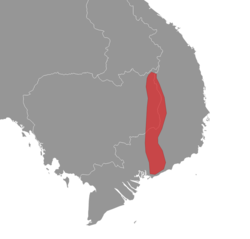 | Size: 4–18 cm (2–7 in) long, plus 4–11 cm (2–4 in) tail [6]
Habitat: Forest [185]
Diet: Invertebrates, small mammals, frogs, toads, and lizards [6] | LC
Unknown  [185] [185]
|
|---|
| Phu Hoc shrew
| C. phuquocensis
Abramov, Jenkins, Rozhnov, & Kalinin, 2008 | Phú Quốc island in Vietnam | Size: 4–18 cm (2–7 in) long, plus 4–11 cm (2–4 in) tail [6]
Habitat: Forest [186]
Diet: Invertebrates, small mammals, frogs, toads, and lizards [6] | VU
Unknown  [186] [186]
|
|---|
| Pitman's shrew
| C. pitmani
Barclay, 1932 | Zambia
 | Size: About 5 cm (2 in) long, plus 4 cm (2 in) tail [187]
Habitat: Unknown [188]
Diet: Invertebrates, small mammals, frogs, toads, and lizards [6] | DD
Unknown  [188] [188]
|
|---|
| Polia's shrew
| C. polia
Hollister, 1916 | Democratic Republic of the Congo
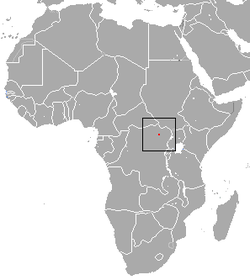 | Size: About 6 cm (2 in) long, plus 7 cm (3 in) tail [81]
Habitat: Unknown [189]
Diet: Invertebrates, small mammals, frogs, toads, and lizards [6] | DD
Unknown  [189] [189]
|
|---|
| Rainey's shrew
| C. raineyi
Heller, 1912 | Kenya
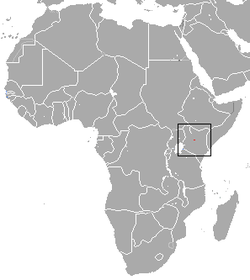 | Size: 9–10 cm (4 in) long, plus 5–7 cm (2–3 in) tail [190]
Habitat: Forest [191]
Diet: Invertebrates, small mammals, frogs, toads, and lizards [6] | EN
Unknown  [191] [191]
|
|---|
| Reddish-gray musk shrew
| C. cyanea
(Duvernoy, 1838) | Southern Africa
 | Size: 6–10 cm (2–4 in) long, plus 3–7 cm (1–3 in) tail [192]
Habitat: Forest, grassland, and caves [193]
Diet: Invertebrates [193] | LC
Unknown  [193] [193]
|
|---|
| Roosevelt's shrew
| C. roosevelti
(Heller, 1910) | Central Africa
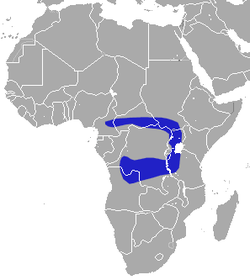 | Size: 4–18 cm (2–7 in) long, plus 4–11 cm (2–4 in) tail [6]
Habitat: Savanna [194]
Diet: Invertebrates, small mammals, frogs, toads, and lizards [6] | LC
Unknown  [194] [194]
|
|---|
| Ryukyu shrew
| C. orii
Kuroda, 1924 | Southern Japan
 | Size: 4–18 cm (2–7 in) long, plus 4–11 cm (2–4 in) tail [6]
Habitat: Forest [195]
Diet: Invertebrates, small mammals, frogs, toads, and lizards [6] | EN
Unknown  [195] [195]
|
|---|
| Sa Pa shrew 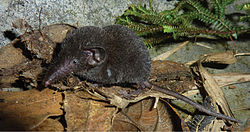 | C. sapaensis
Jenkins, Abramov, Bannikova, & Rozhnov, 2013 | Vietnam | Size: 4–18 cm (2–7 in) long, plus 4–11 cm (2–4 in) tail [6]
Habitat: Forest and grassland [196]
Diet: Invertebrates, small mammals, frogs, toads, and lizards [6] | DD
Unknown  [196] [196]
|
|---|
| Saharan shrew
| C. tarfayensis
Vesmanis & Vesmanis, 1980 | Mauritania and Morocco
 | Size: 4–18 cm (2–7 in) long, plus 4–11 cm (2–4 in) tail [6]
Habitat: Rocky areas and desert [197]
Diet: Invertebrates, small mammals, frogs, toads, and lizards [6] | DD
Unknown  [197] [197]
|
|---|
| Sahelian tiny shrew
| C. pasha
Dollman, 1915 | Scattered northern Africa
 | Size: 4–6 cm (2 in) long, plus 2–4 cm (1–2 in) tail [198]
Habitat: Savanna [199]
Diet: Invertebrates, small mammals, frogs, toads, and lizards [6] | LC
Unknown  [199] [199]
|
|---|
| Savanna dwarf shrew
| C. nanilla
Thomas, 1909 | Western and eastern Africa
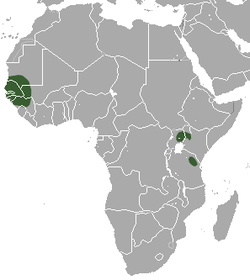 | Size: 4–6 cm (2–2 in) long, plus 3–5 cm (1–2 in) tail [200]
Habitat: Savanna [201]
Diet: Invertebrates, small mammals, frogs, toads, and lizards [6] | LC
Unknown  [201] [201]
|
|---|
| Savanna path shrew
| C. viaria
(Geoffroy, 1834) | Western, central, and eastern Africa
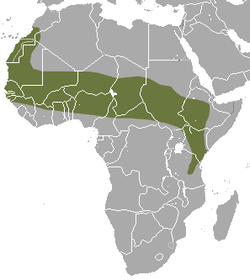 | Size: 4–18 cm (2–7 in) long, plus 4–11 cm (2–4 in) tail [6]
Habitat: Forest and savanna [202]
Diet: Invertebrates, small mammals, frogs, toads, and lizards [6] | LC
Unknown  [202] [202]
|
|---|
| Savanna shrew
| C. fulvastra
(Sundevall, 1843) | Central Africa
 | Size: 4–18 cm (2–7 in) long, plus 4–11 cm (2–4 in) tail [6]
Habitat: Savanna [203]
Diet: Invertebrates, small mammals, frogs, toads, and lizards [6] | LC
Unknown  [203] [203]
|
|---|
| Savanna swamp shrew
| C. longipes
Hutterer & Happold, 1983 | West-central Africa
 | Size: 9–12 cm (4–5 in) long, plus 5–7 cm (2–3 in) tail [204]
Habitat: Inland wetlands [205]
Diet: Invertebrates, small mammals, frogs, toads, and lizards [6] | DD
Unknown  [205] [205]
|
|---|
| Siberian shrew
| C. sibirica
Dukelsky, 1930 | Central Asia
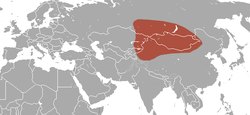 | Size: 4–18 cm (2–7 in) long, plus 4–11 cm (2–4 in) tail [6]
Habitat: Forest, grassland, inland wetlands, and desert [206]
Diet: Invertebrates, small mammals, frogs, toads, and lizards [6] | LC
Unknown  [206] [206]
|
|---|
| Sibuyan shrew
| C. ninoyi
Esselstyn & Goodman, 2010 | Philippines
 | Size: 4–18 cm (2–7 in) long, plus 4–11 cm (2–4 in) tail [6]
Habitat: Forest [207]
Diet: Invertebrates, small mammals, frogs, toads, and lizards [6] | DD
Unknown  [207] [207]
|
|---|
| Sicilian shrew 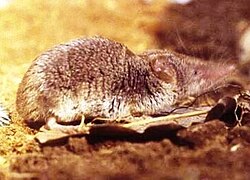 | C. sicula
Miller, 1900
- C. s. aegatensis
- C. s. calypso
- C. s. esuae
- C. s. sicula
| Italy and Malta
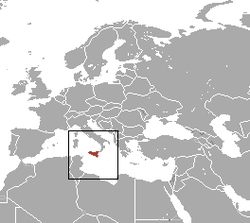 | Size: 4–18 cm (2–7 in) long, plus 4–11 cm (2–4 in) tail [6]
Habitat: Shrubland [208]
Diet: Invertebrates, small mammals, frogs, toads, and lizards [6] | LC
Unknown  [208] [208]
|
|---|
| Sinharaja white-toothed shrew
| C. hikmiya
Meegaskumbura, Meegaskumbura, Pethiyagoda, Manamendra-Arachchi, & Schneider, 2007 | Sri Lanka
 | Size: 4–18 cm (2–7 in) long, plus 4–11 cm (2–4 in) tail [6]
Habitat: Forest [209]
Diet: Invertebrates, small mammals, frogs, toads, and lizards [6] | EN
Unknown  [209] [209]
|
|---|
| Small-footed shrew
| C. parvipes
Osgood, 1910 | Central Africa
| Size: 6–9 cm (2–4 in) long, plus 3–6 cm (1–2 in) tail [210]
Habitat: Forest, savanna, and shrubland
Diet: Invertebrates, small mammals, frogs, toads, and lizards [6] | LC
Unknown 
|
|---|
| Smoky white-toothed shrew
| C. fumosa
Thomas, 1904 | Kenya
 | Size: 4–18 cm (2–7 in) long, plus 4–11 cm (2–4 in) tail [6]
Habitat: Forest [212]
Diet: Invertebrates, small mammals, frogs, toads, and lizards [6] | LC
Unknown  [212] [212]
|
|---|
| Sokolov's shrew
| C. sokolovi
Jenkins, Abramov, Rozhnov, & Makarova, 2007 | Vietnam | Size: 4–18 cm (2–7 in) long, plus 4–11 cm (2–4 in) tail [6]
Habitat: Forest [213]
Diet: Invertebrates, small mammals, frogs, toads, and lizards [6] | NT
Unknown  [213] [213]
|
|---|
| Somali dwarf shrew
| C. nana
Dobson, 1890 | Ethiopia and Somalia
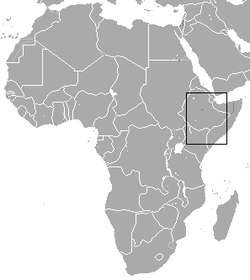 | Size: About 4 cm (2 in) long, plus 3 cm (1 in) tail [214]
Habitat: Grassland [215]
Diet: Invertebrates, small mammals, frogs, toads, and lizards [6] | DD
Unknown  [215] [215]
|
|---|
| Somali shrew
| C. somalica
Thomas, 1895 | Eastern Africa
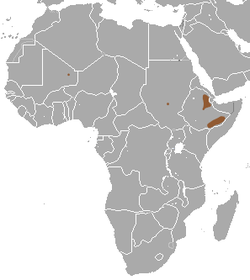 | Size: 6–8 cm (2–3 in) long, plus 4–5 cm (2–2 in) tail [166]
Habitat: Savanna [216]
Diet: Invertebrates, small mammals, frogs, toads, and lizards [6] | LC
Unknown  [216] [216]
|
|---|
| Southeast Asian shrew 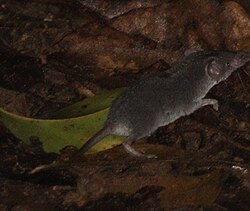 | C. fuliginosa
(Blyth, 1856) | Southeastern Asian
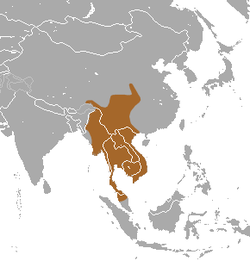 | Size: 4–18 cm (2–7 in) long, plus 4–11 cm (2–4 in) tail [6]
Habitat: Forest, shrubland, grassland, and rocky areas [217]
Diet: Invertebrates, small mammals, frogs, toads, and lizards [6] | LC
Unknown  [217] [217]
|
|---|
| Sri Lankan long-tailed shrew
| C. miya
Phillips, 1929 | Sri Lanka
 | Size: 4–18 cm (2–7 in) long, plus 4–11 cm (2–4 in) tail [6]
Habitat: Forest [218]
Diet: Invertebrates, small mammals, frogs, toads, and lizards [6] | EN
Unknown  [218] [218]
|
|---|
| Sulawesi shrew
| C. lea
Miller & Hollister, 1921 | Sulawesi island in Indonesia
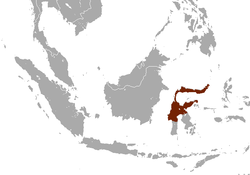 | Size: 4–18 cm (2–7 in) long, plus 4–11 cm (2–4 in) tail [6]
Habitat: Forest [219]
Diet: Invertebrates, small mammals, frogs, toads, and lizards [6] | LC
Unknown  [219] [219]
|
|---|
| Sulawesi tiny shrew
| C. levicula
Miller & Hollister, 1921 | Sulawesi island in Indonesia
 | Size: 4–18 cm (2–7 in) long, plus 4–11 cm (2–4 in) tail [6]
Habitat: Forest [220]
Diet: Invertebrates, small mammals, frogs, toads, and lizards [6] | LC
Unknown  [220] [220]
|
|---|
| Sulawesi white-handed shrew
| C. rhoditis
Miller & Hollister, 1921 | Sulawesi island in Indonesia
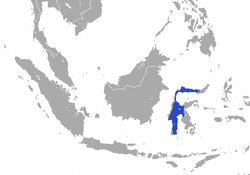 | Size: 4–18 cm (2–7 in) long, plus 4–11 cm (2–4 in) tail [6]
Habitat: Forest [221]
Diet: Invertebrates, small mammals, frogs, toads, and lizards [6] | VU
Unknown  [221] [221]
|
|---|
| Sumatran giant shrew
| C. lepidura
Lyon, 1908 | Sumatra island in Indonesia
 | Size: 4–18 cm (2–7 in) long, plus 4–11 cm (2–4 in) tail [6]
Habitat: Forest and shrubland [222]
Diet: Invertebrates, small mammals, frogs, toads, and lizards [6] | LC
Unknown  [222] [222]
|
|---|
| Sumatran long-tailed shrew
| C. paradoxura
Dobson, 1886 | Sumatra island in Indonesia
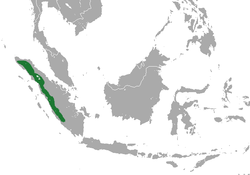 | Size: 4–18 cm (2–7 in) long, plus 4–11 cm (2–4 in) tail [6]
Habitat: Forest [223]
Diet: Invertebrates, small mammals, frogs, toads, and lizards [6] | LC
Unknown  [223] [223]
|
|---|
| Sunda shrew  | C. monticola
Peters, 1870 | Southeastern Asia
 | Size: 4–18 cm (2–7 in) long, plus 4–11 cm (2–4 in) tail [6]
Habitat: Forest [224]
Diet: Invertebrates, small mammals, frogs, toads, and lizards [6] | LC
Unknown  [224] [224]
|
|---|
| Swamp musk shrew
| C. mariquensis
(Smith, 1844)
- C. m. mariquensis
- C. m. neavei
- C. m. shortridgei
| Southern Africa
 | Size: 4–18 cm (2–7 in) long, plus 4–11 cm (2–4 in) tail [6]
Habitat: Inland wetlands [225]
Diet: Invertebrates, small mammals, frogs, toads, and lizards [6] | LC
Unknown  [225] [225]
|
|---|
| São Tomé shrew  | C. thomensis
(Bocage, 1887) | São Tomé Island in São Tomé and Príncipe
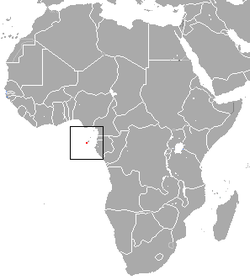 | Size: 4–18 cm (2–7 in) long, plus 4–11 cm (2–4 in) tail [6]
Habitat: Forest [226]
Diet: Invertebrates, small mammals, frogs, toads, and lizards [6] | EN
Unknown  [226] [226]
|
|---|
| Taiwanese gray shrew
| C. tanakae
Kuroda, 1938 | Eastern Asia
 | Size: 4–18 cm (2–7 in) long, plus 4–11 cm (2–4 in) tail [6]
Habitat: Forest and grassland [227]
Diet: Invertebrates, small mammals, frogs, toads, and lizards [6] | LC
Unknown  [227] [227]
|
|---|
| Tanzanian shrew
| C. tansaniana
Hutterer, 1986 | Tanzania
 | Size: 8–11 cm (3–4 in) long, plus 5–8 cm (2–3 in) tail [228]
Habitat: Forest [229]
Diet: Invertebrates, small mammals, frogs, toads, and lizards [6] | NT
Unknown  [229] [229]
|
|---|
| Tarella shrew
| C. tarella
Dollman, 1915 | Central Africa
 | Size: 4–18 cm (2–7 in) long, plus 4–11 cm (2–4 in) tail [6]
Habitat: Forest [230]
Diet: Invertebrates, small mammals, frogs, toads, and lizards [6] | EN
Unknown  [230] [230]
|
|---|
| Telford's shrew
| C. telfordi
Hutterer, 1986 | Tanzania
 | Size: 10–11 cm (4 in) long, plus 7–9 cm (3–4 in) tail [231]
Habitat: Forest [232]
Diet: Invertebrates, small mammals, frogs, toads, and lizards [6] | VU
Unknown  [232] [232]
|
|---|
| Thalia's shrew
| C. thalia
Dippenaar, 1980 | Ethiopia
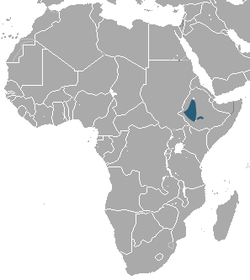 | Size: 7–10 cm (3–4 in) long, plus 5–7 cm (2–3 in) tail [231]
Habitat: Forest, savanna, shrubland, grassland, and inland wetlands [233]
Diet: Invertebrates, small mammals, frogs, toads, and lizards [6] | LC
Unknown  [233] [233]
|
|---|
| Therese's shrew
| C. theresae
Heim de Balsac, 1968 | Western Africa
 | Size: 7–11 cm (3–4 in) long, plus 3–6 cm (1–2 in) tail [234]
Habitat: Forest and savanna [235]
Diet: Invertebrates, small mammals, frogs, toads, and lizards [6] | LC
Unknown  [235] [235]
|
|---|
| Thick-tailed shrew
| C. brunnea
Jentink, 1888
- C. b. brunnea
- C. b. pudjonica
| Indonesia
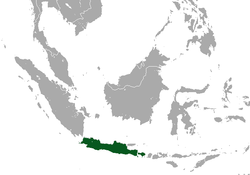 | Size: 4–18 cm (2–7 in) long, plus 4–11 cm (2–4 in) tail [6]
Habitat: Forest [236]
Diet: Invertebrates, small mammals, frogs, toads, and lizards [6] | LC
Unknown  [236] [236]
|
|---|
| Timor shrew
| C. tenuis
(Müller, 1840) | Timor
 | Size: 4–18 cm (2–7 in) long, plus 4–11 cm (2–4 in) tail [6]
Habitat: Forest [237]
Diet: Invertebrates, small mammals, frogs, toads, and lizards [6] | DD
Unknown  [237] [237]
|
|---|
| Turbo shrew
| C. turba
Dollman, 1910 | Central Africa
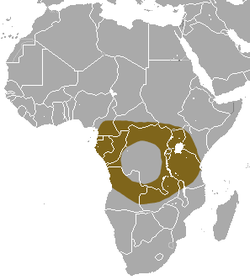 | Size: 9–11 cm (4 in) long, plus 5–6 cm (2–2 in) tail [238]
Habitat: Forest [239]
Diet: Invertebrates, small mammals, frogs, toads, and lizards [6] | LC
Unknown  [239] [239]
|
|---|
| Ugandan lowland shrew
| C. selina
(Dollman, 1915) | Kenya and Uganda
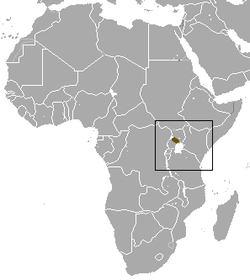 | Size: 7–9 cm (3–4 in) long, plus 5–7 cm (2–3 in) tail [240]
Habitat: Forest and inland wetlands [241]
Diet: Invertebrates, small mammals, frogs, toads, and lizards [6] | DD
Unknown  [241] [241]
|
|---|
| Ugandan musk shrew
| C. mutesae
Heller, 1910 | Central Africa
 | Size: About 11 cm (4 in) long, plus 6 cm (2 in) tail [214]
Habitat: Forest [242]
Diet: Invertebrates, small mammals, frogs, toads, and lizards [6] | DD
Unknown  [242] [242]
|
|---|
| Ultimate shrew
| C. ultima
Dollman, 1915 | Kenya
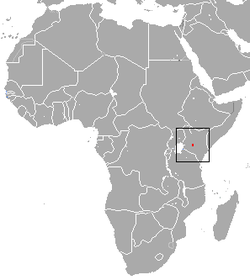 | Size: About 9 cm (4 in) long, plus 6 cm (2 in) tail [243]
Habitat: Forest [244]
Diet: Invertebrates, small mammals, frogs, toads, and lizards [6] | DD
Unknown  [244] [244]
|
|---|
| Upemba shrew
| C. zimmeri
Osgood, 1936 | Democratic Republic of the Congo
 | Size: 11–13 cm (4–5 in) long, plus 4–6 cm (2–2 in) tail [245]
Habitat: Unknown [246]
Diet: Invertebrates, small mammals, frogs, toads, and lizards [6] | DD
Unknown  [246] [246]
|
|---|
| Usambara shrew
| C. usambarae
Dippenaar, 1980 | Tanzania
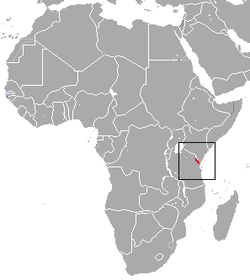 | Size: 7–9 cm (3–4 in) long, plus 5–7 cm (2–3 in) tail [247]
Habitat: Forest [248]
Diet: Invertebrates, small mammals, frogs, toads, and lizards [6] | VU
Unknown  [248] [248]
|
|---|
| Ussuri white-toothed shrew  | C. lasiura
(Dobson, 1890) | Eastern Asia
 | Size: 4–18 cm (2–7 in) long, plus 4–11 cm (2–4 in) tail [6]
Habitat: Grassland [249]
Diet: Insects and other invertebrates, as well as small vertebrates [249] | LC
Unknown  [249] [249]
|
|---|
| Voi shrew
| C. voi
Osgood, 1910 | Central and eastern Africa
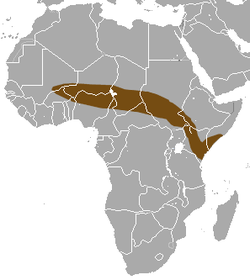 | Size: 4–18 cm (2–7 in) long, plus 4–11 cm (2–4 in) tail [6]
Habitat: Savanna [250]
Diet: Invertebrates, small mammals, frogs, toads, and lizards [6] | LC
Unknown  [250] [250]
|
|---|
| Voracious shrew 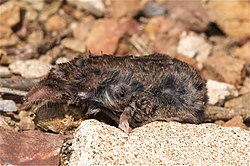 | C. vorax
Allen, 1923 | Southeastern Asia
 | Size: 4–18 cm (2–7 in) long, plus 4–11 cm (2–4 in) tail [6]
Habitat: Forest [251]
Diet: Invertebrates, small mammals, frogs, toads, and lizards [6] | LC
Unknown  [251] [251]
|
|---|
| West African long-tailed shrew
| C. muricauda
(Miller, 1900) | Western Africa
 | Size: 5–7 cm (2–3 in) long, plus tail [252]
Habitat: Forest [253]
Diet: Invertebrates, small mammals, frogs, toads, and lizards [6] | LC
Unknown  [253] [253]
|
|---|
| West African pygmy shrew
| C. obscurior
Heim de Balsac, 1958 | Western Africa
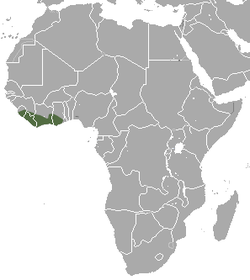 | Size: 4–5 cm (2–2 in) long, plus 3–4 cm (1–2 in) tail [254]
Habitat: Forest [255]
Diet: Invertebrates, small mammals, frogs, toads, and lizards [6] | LC
Unknown  [255] [255]
|
|---|
| Whitaker's shrew
| C. whitakeri
De Winton, 1898 | Northwestern Africa
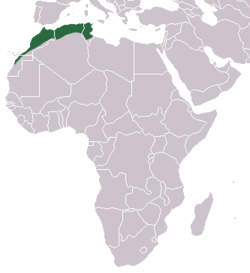 | Size: 5–7 cm (2–3 in) long, plus 2–4 cm (1–2 in) tail [256]
Habitat: Coastal marine, intertidal marine, and shrubland
Diet: Invertebrates, small mammals, frogs, toads, and lizards [6] | LC
Unknown 
|
|---|
| Wimmer's shrew
| C. wimmeri
Heim de Balsac & Aellen, 1958 | Ivory Coast
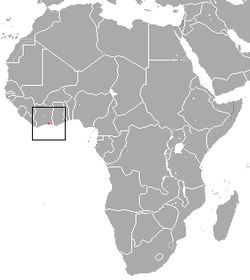 | Size: 8–9 cm (3–4 in) long, plus 5–6 cm (2–2 in) tail [258]
Habitat: Forest
Diet: Invertebrates, small mammals, frogs, toads, and lizards [6] | VU
Unknown 
|
|---|
| Xanthippe's shrew
| C. xantippe
Osgood, 1910 | Kenya and Tanzania
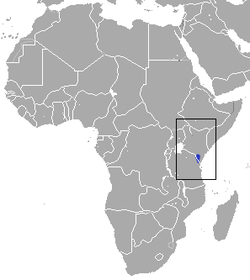 | Size: 8–10 cm (3–4 in) long, plus 5–7 cm (2–3 in) tail [260]
Habitat: Savanna and shrubland [261]
Diet: Invertebrates, small mammals, frogs, toads, and lizards [6] | LC
Unknown  [261] [261]
|
|---|
| Yankari shrew
| C. yankariensis
Hutterer & Jenkins, 1980 | Central and eastern Africa
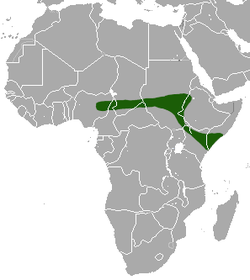 | Size: 5–7 cm (2–3 in) long, plus 3–5 cm (1–2 in) tail [260]
Habitat: Savanna [262]
Diet: Invertebrates, small mammals, frogs, toads, and lizards [6] | LC
Unknown  [262] [262]
|
|---|
| Zaphir's shrew
| C. zaphiri
Dollman, 1915 | Ethiopia and Kenya
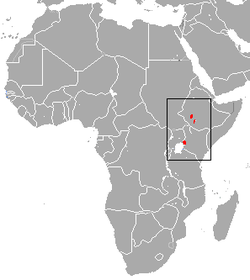 | Size: About 10 cm (4 in) long, plus 6 cm (2 in) tail [263]
Habitat: Unknown
Diet: Invertebrates, small mammals, frogs, toads, and lizards [6] | DD
Unknown 
|
|---|
| Zarudny's rock shrew  | C. zarudnyi
Ognew, 1928 | Central Asia
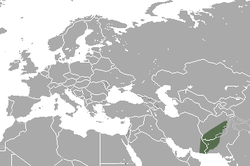 | Size: 4–18 cm (2–7 in) long, plus 4–11 cm (2–4 in) tail [6]
Habitat: Desert [265]
Diet: Invertebrates, small mammals, frogs, toads, and lizards [6] | LC
Unknown  [265] [265]
|
|---|



































































































































































































